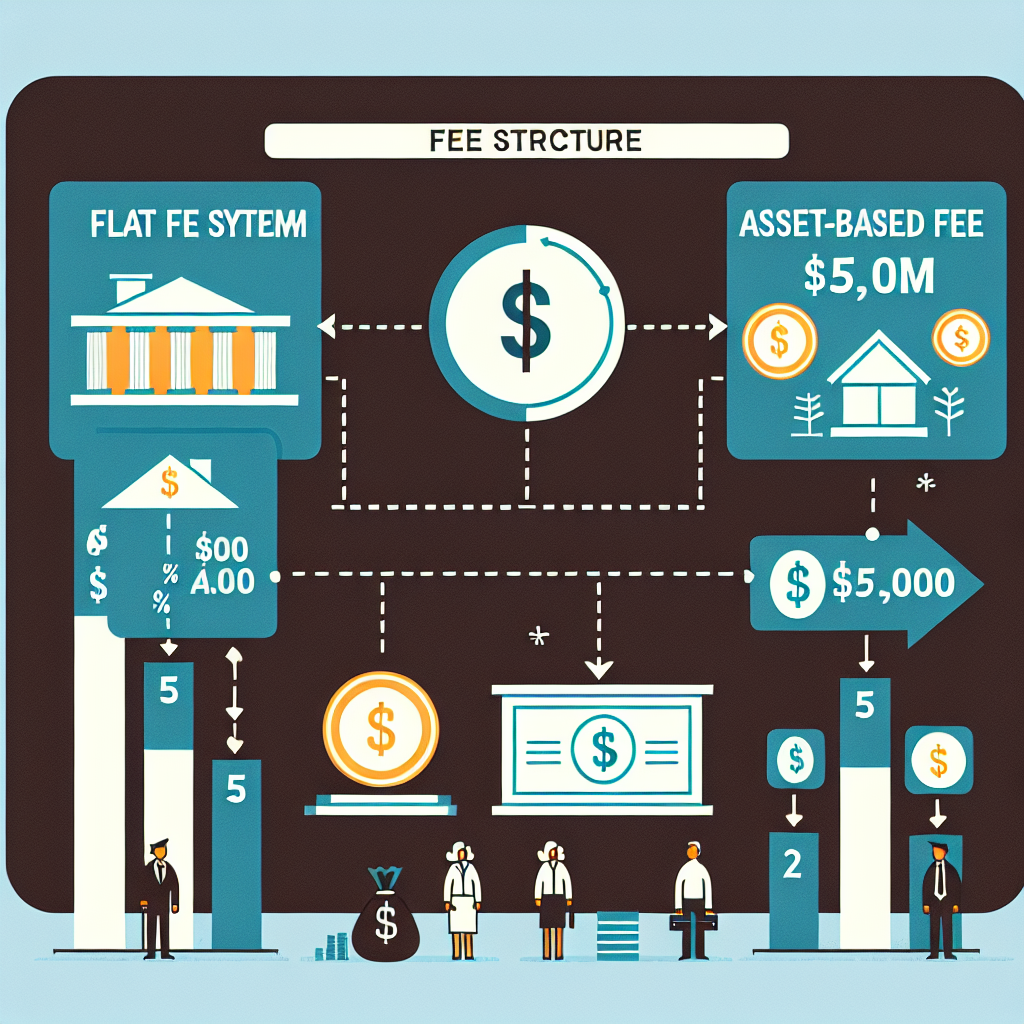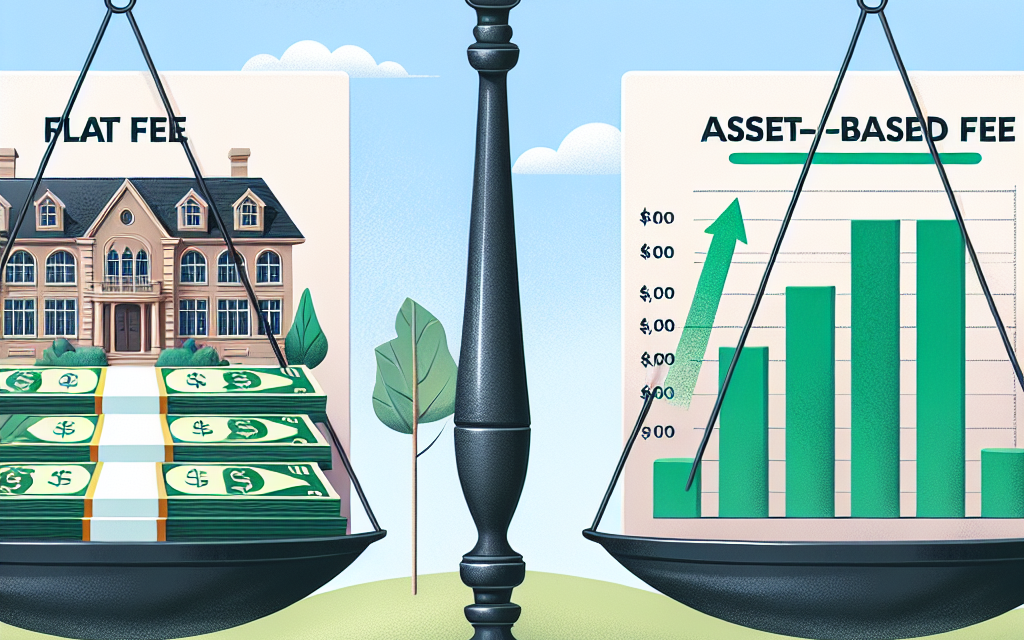“Maximize Your Estate’s Potential: Flat Fee Clarity vs. Asset-Based Growth”
Introduction
Choosing the best fee structure for managing a $5 million estate is a critical decision that can significantly impact the estate’s long-term growth and sustainability. Estate management involves a range of services, including investment management, tax planning, and legal compliance, each of which can be billed differently depending on the chosen fee structure. Two common fee structures are the flat fee and the asset-based fee. A flat fee involves a predetermined charge for services, offering predictability and simplicity, while an asset-based fee is calculated as a percentage of the estate’s total value, aligning the manager’s incentives with the estate’s performance. Understanding the advantages and potential drawbacks of each approach is essential for estate holders to make an informed decision that aligns with their financial goals and management preferences.
Understanding Flat Fee Structures for Estate Management
When managing a $5 million estate, selecting the appropriate fee structure is crucial to ensure both cost-effectiveness and optimal service. Among the various options available, flat fee structures and asset-based fees are two prevalent choices. Understanding the nuances of flat fee structures can provide clarity and assist in making an informed decision.
Flat fee structures offer a straightforward approach to estate management. Under this model, a predetermined fee is agreed upon for the services rendered, regardless of the estate’s value or the time required to manage it. This can be particularly advantageous for estate holders who prefer predictability in their financial planning. By knowing the exact cost upfront, estate owners can budget more effectively without the concern of fluctuating fees that might arise from changes in the estate’s value or unforeseen complexities in its management.
Moreover, flat fee structures can foster a sense of trust and transparency between the estate manager and the client. Since the fee is fixed, there is no incentive for the manager to prolong tasks or increase the estate’s value unnecessarily to boost their compensation. This can lead to a more efficient and focused management process, as the manager’s primary goal is to meet the client’s needs within the agreed-upon fee.
However, it is essential to consider the potential drawbacks of a flat fee structure. One significant concern is that it may not always align with the complexity or size of the estate. For instance, if an estate requires extensive management due to its diverse assets or intricate legal considerations, a flat fee might not adequately compensate the manager for their time and expertise. This could result in a less thorough management approach, as the manager might be inclined to prioritize tasks that fit within the fee structure rather than addressing all aspects of the estate comprehensively.
In contrast, asset-based fees, which are calculated as a percentage of the estate’s total value, offer a different set of advantages and challenges. This model aligns the manager’s compensation with the estate’s performance, potentially incentivizing them to maximize the estate’s value. However, it can also lead to higher costs, especially if the estate’s value increases significantly over time.
When deciding between a flat fee and an asset-based fee, it is crucial to assess the specific needs and characteristics of the estate. For estates with relatively straightforward management requirements, a flat fee might provide the best balance of cost and service. Conversely, for more complex estates, an asset-based fee could ensure that the manager is adequately motivated to address all aspects of the estate’s management.
Ultimately, the choice between a flat fee and an asset-based fee should be guided by a thorough evaluation of the estate’s needs, the manager’s expertise, and the client’s financial preferences. By carefully considering these factors, estate holders can select a fee structure that not only aligns with their financial goals but also ensures that their estate is managed effectively and efficiently. In doing so, they can achieve peace of mind, knowing that their estate is in capable hands and that their financial interests are being safeguarded.
Exploring Asset-Based Fees for Estate Management
When managing a $5 million estate, selecting the appropriate fee structure is a critical decision that can significantly impact the estate’s long-term financial health. Among the various options available, asset-based fees have emerged as a popular choice for many estate managers and beneficiaries. This fee structure, which charges a percentage of the total assets under management, offers several advantages and potential drawbacks that warrant careful consideration.
To begin with, asset-based fees align the interests of the estate manager with those of the estate owner. Since the manager’s compensation is directly tied to the value of the assets, there is a natural incentive to maximize the estate’s growth. This alignment can foster a more proactive and diligent approach to investment decisions, as the manager benefits from the estate’s success. Furthermore, asset-based fees provide a level of predictability and transparency, as they are typically calculated annually based on the estate’s value. This allows estate owners to anticipate costs and plan accordingly, without the uncertainty of fluctuating charges.
However, it is essential to weigh these benefits against potential drawbacks. One concern is that asset-based fees can become disproportionately high as the estate grows. For instance, a 1% fee on a $5 million estate amounts to $50,000 annually, which can significantly impact the estate’s net returns over time. This is particularly relevant for estates that are expected to appreciate substantially, as the fees will increase correspondingly. Additionally, there is a risk that estate managers may prioritize asset growth over other important considerations, such as risk management or liquidity needs, in pursuit of higher fees.
In contrast, flat fees offer an alternative that may be more suitable for certain estates. A flat fee structure involves a predetermined charge for managing the estate, regardless of its size or performance. This can be advantageous for estate owners who prefer cost certainty and wish to avoid the potential escalation of fees associated with asset-based structures. Moreover, flat fees can encourage estate managers to focus on holistic financial planning, as their compensation is not directly linked to asset growth.
Nevertheless, flat fees also have their limitations. They may not provide the same level of motivation for estate managers to enhance the estate’s value, as their earnings remain constant regardless of performance. This could lead to a more passive management approach, which may not be ideal for estates seeking aggressive growth strategies. Additionally, flat fees may not adequately reflect the complexity or demands of managing a larger estate, potentially resulting in either overpayment or underpayment for the services rendered.
Ultimately, the choice between asset-based and flat fee structures depends on the specific goals and circumstances of the estate. For those prioritizing growth and alignment of interests, asset-based fees may be more appropriate. Conversely, estates seeking cost stability and comprehensive financial planning might benefit from a flat fee arrangement. It is crucial for estate owners to carefully evaluate their priorities and consult with financial advisors to determine the most suitable fee structure. By doing so, they can ensure that their estate is managed effectively, with a fee arrangement that supports their long-term objectives.
Pros and Cons of Flat Fee vs. Asset-Based Fee
When managing a $5 million estate, selecting the appropriate fee structure is a critical decision that can significantly impact the estate’s financial health. Two prevalent fee structures are the flat fee and the asset-based fee, each with its own set of advantages and disadvantages. Understanding these can help estate owners make informed decisions that align with their financial goals and management preferences.
A flat fee structure involves a predetermined amount paid for estate management services, regardless of the estate’s value or the complexity of the tasks involved. One of the primary advantages of this approach is predictability. Estate owners can budget more effectively, knowing exactly what they will pay for management services. This can be particularly beneficial for those who prefer financial certainty and wish to avoid unexpected expenses. Moreover, a flat fee can simplify the decision-making process, as it eliminates the need to constantly evaluate the cost-effectiveness of the services provided.
However, the flat fee structure is not without its drawbacks. It may not always reflect the true value of the services rendered, especially if the estate requires extensive management or if its value fluctuates significantly. In such cases, estate owners might end up paying more than necessary for basic services or, conversely, receive inadequate attention if the fee does not justify the effort required. Additionally, flat fees may not incentivize managers to maximize the estate’s performance, as their compensation remains constant regardless of the estate’s growth or decline.
In contrast, an asset-based fee structure ties the manager’s compensation to a percentage of the estate’s total value. This approach aligns the interests of the estate manager with those of the estate owner, as both parties benefit from the estate’s growth. Consequently, managers may be more motivated to enhance the estate’s performance, knowing that their earnings will increase as the estate’s value rises. This can lead to more proactive and dynamic management strategies, potentially resulting in higher returns for the estate owner.
Nevertheless, asset-based fees also present certain challenges. As the estate’s value increases, so does the manager’s compensation, which can lead to substantial fees over time. This can be particularly concerning for estate owners who prioritize cost control and wish to minimize management expenses. Furthermore, in periods of market volatility or economic downturns, the estate’s value may decrease, yet the percentage-based fee structure could still result in significant costs relative to the estate’s diminished worth.
In conclusion, both flat fee and asset-based fee structures offer distinct advantages and disadvantages when managing a $5 million estate. The choice between them largely depends on the estate owner’s priorities, such as the desire for cost predictability versus performance incentives. By carefully weighing these factors, estate owners can select a fee structure that best suits their financial objectives and management style. Ultimately, the decision should be guided by a thorough understanding of each option’s implications, ensuring that the chosen structure aligns with the estate’s long-term goals and the owner’s personal preferences.
How Estate Size Influences Fee Structure Decisions

When managing a $5 million estate, selecting the appropriate fee structure is a critical decision that can significantly impact the estate’s long-term financial health. The two primary fee structures to consider are the flat fee and the asset-based fee. Each has its own set of advantages and disadvantages, and the size of the estate plays a pivotal role in determining which structure is most suitable.
To begin with, a flat fee structure involves a predetermined amount paid for estate management services, regardless of the estate’s size or complexity. This approach offers predictability and simplicity, as the estate owner knows exactly what the management costs will be. For estates that are relatively straightforward, with fewer assets and less complexity, a flat fee can be an attractive option. It eliminates the uncertainty of fluctuating fees and allows for straightforward budgeting. However, for a $5 million estate, which may involve diverse assets such as real estate, investments, and business interests, a flat fee might not adequately reflect the level of work required to manage the estate effectively.
In contrast, an asset-based fee structure charges a percentage of the total assets under management. This approach aligns the interests of the estate manager with those of the estate owner, as the manager’s compensation is directly tied to the estate’s value. For larger estates, such as one valued at $5 million, an asset-based fee can be more appropriate. It ensures that the estate manager is incentivized to maximize the estate’s value, as their compensation increases with the estate’s growth. However, this structure can also lead to higher costs, especially if the estate’s value appreciates significantly over time.
Transitioning from the general characteristics of each fee structure, it is essential to consider how the specific attributes of a $5 million estate influence the decision-making process. The complexity and diversity of assets within such an estate often necessitate a more hands-on management approach. An asset-based fee structure may be more suitable in this context, as it provides the estate manager with the motivation to actively manage and grow the estate’s assets. Additionally, the scalability of an asset-based fee can accommodate changes in the estate’s value, offering flexibility that a flat fee might lack.
Nevertheless, it is crucial to weigh the potential drawbacks of an asset-based fee. The percentage charged can vary significantly among estate managers, and even a small difference in percentage points can lead to substantial cost variations over time. Therefore, estate owners must carefully evaluate the fee percentage and ensure it aligns with their financial goals and expectations.
In conclusion, the decision between a flat fee and an asset-based fee for managing a $5 million estate hinges on several factors, including the estate’s complexity, the diversity of its assets, and the owner’s financial objectives. While a flat fee offers predictability and simplicity, an asset-based fee aligns the manager’s incentives with the estate’s growth potential. Ultimately, estate owners should conduct a thorough analysis of their estate’s specific needs and consult with financial advisors to determine the most suitable fee structure. By doing so, they can ensure that their estate is managed effectively, maximizing its value for future generations.
Comparing Cost Efficiency: Flat Fee vs. Asset-Based Fee
When managing a $5 million estate, selecting the appropriate fee structure is crucial for ensuring cost efficiency and maximizing the estate’s value. Two common fee structures often considered are the flat fee and the asset-based fee. Each has its own advantages and potential drawbacks, making it essential to understand their implications fully before making a decision.
To begin with, a flat fee structure involves a predetermined, fixed amount paid for estate management services, regardless of the estate’s size or complexity. This approach offers predictability and transparency, as the estate owner knows exactly what the management costs will be from the outset. This can be particularly advantageous for those who prefer to avoid unexpected expenses and value straightforward financial planning. Moreover, a flat fee can be beneficial when the estate’s needs are relatively stable and do not require frequent adjustments or intensive management efforts. However, it is important to consider that a flat fee might not always align with the level of service required, especially if the estate’s complexity increases over time.
In contrast, an asset-based fee structure calculates the management fee as a percentage of the total assets under management. This approach aligns the interests of the estate manager with those of the estate owner, as the manager’s compensation is directly tied to the estate’s performance. Consequently, this can incentivize the manager to focus on growing the estate’s value. Additionally, an asset-based fee can be more flexible, adjusting to the estate’s changing needs and complexities. However, it is crucial to recognize that as the estate’s value increases, so too does the management fee, which could potentially lead to higher costs over time compared to a flat fee structure.
When comparing these two fee structures, it is essential to consider the specific circumstances and goals of the estate. For instance, if the estate is expected to remain relatively stable with minimal changes, a flat fee might offer the most cost-effective solution. On the other hand, if the estate is likely to experience significant growth or requires active management, an asset-based fee could provide better alignment with the estate’s objectives.
Furthermore, it is important to evaluate the level of service and expertise provided under each fee structure. A flat fee might cover only basic management services, whereas an asset-based fee could include more comprehensive support, such as investment advice and strategic planning. Therefore, understanding the scope of services included in each fee structure is vital for making an informed decision.
In addition to these considerations, estate owners should also assess their own preferences and risk tolerance. Some individuals may prioritize cost certainty and prefer the predictability of a flat fee, while others might be more comfortable with the potential variability of an asset-based fee, especially if they believe in the potential for significant estate growth.
Ultimately, choosing the best fee structure for managing a $5 million estate requires a careful evaluation of the estate’s characteristics, the level of service required, and the estate owner’s financial goals and preferences. By weighing the advantages and potential drawbacks of both flat fee and asset-based fee structures, estate owners can make a well-informed decision that aligns with their long-term objectives and ensures cost efficiency in managing their valuable assets.
Legal Considerations in Choosing Estate Management Fees
When managing a $5 million estate, selecting the appropriate fee structure is a critical decision that can significantly impact the estate’s financial health and the beneficiaries’ interests. Two prevalent fee structures in estate management are the flat fee and the asset-based fee. Each has its own set of advantages and potential drawbacks, and understanding these can guide estate holders and their advisors in making an informed choice.
To begin with, a flat fee structure involves a predetermined amount paid for estate management services, regardless of the estate’s value or the complexity of the tasks involved. This approach offers predictability and transparency, as the estate holder knows the exact cost upfront. Such predictability can be particularly advantageous in budgeting and financial planning, ensuring that the estate’s resources are allocated efficiently. Moreover, a flat fee can prevent conflicts of interest, as the estate manager’s compensation is not tied to the estate’s value, thereby aligning their interests more closely with those of the estate holder.
However, the flat fee structure is not without its limitations. It may not adequately account for the varying levels of effort required to manage different estates. For instance, a $5 million estate with diverse assets and complex legal considerations may demand more time and expertise than a similarly valued estate with simpler holdings. In such cases, a flat fee might either overcompensate or undercompensate the estate manager, potentially leading to dissatisfaction on either side.
On the other hand, an asset-based fee structure calculates the manager’s compensation as a percentage of the estate’s total value. This method inherently adjusts for the size of the estate, potentially offering a more equitable compensation model for the manager. As the estate grows, so does the manager’s fee, which can incentivize the manager to enhance the estate’s value. This alignment of interests can be beneficial, fostering a proactive approach to estate management.
Nevertheless, the asset-based fee structure also presents challenges. It can lead to higher costs for larger estates, which may not always correlate with increased management complexity. Additionally, this model might encourage estate managers to prioritize strategies that increase the estate’s value, possibly at the expense of other important considerations, such as risk management or the specific wishes of the estate holder.
In navigating these options, legal considerations play a pivotal role. Estate holders must ensure that the chosen fee structure complies with relevant laws and regulations, which can vary significantly by jurisdiction. Consulting with legal professionals who specialize in estate management is advisable to ensure that all contractual agreements are legally sound and protect the interests of both the estate holder and the beneficiaries.
Furthermore, transparency and clear communication are essential in establishing a fee structure. Estate holders should engage in open discussions with potential managers to understand the rationale behind their fee proposals and to negotiate terms that reflect the estate’s unique needs and objectives. This dialogue can help prevent misunderstandings and foster a collaborative relationship between the estate holder and the manager.
In conclusion, choosing between a flat fee and an asset-based fee structure for managing a $5 million estate involves careful consideration of the estate’s characteristics, the manager’s role, and the legal framework governing such arrangements. By weighing the pros and cons of each approach and seeking expert legal advice, estate holders can make a decision that aligns with their financial goals and ensures the effective stewardship of their assets.
Case Studies: Successful Fee Structures for $5 Million Estates
When managing a $5 million estate, selecting the appropriate fee structure is crucial for ensuring both the estate’s growth and the satisfaction of the beneficiaries. Two prevalent fee structures often considered are the flat fee and the asset-based fee. Each has its own set of advantages and potential drawbacks, and understanding these can help in making an informed decision. By examining case studies of successful fee structures, we can gain insights into how each model operates in practice and which might be more suitable for a particular estate.
In one case study, a $5 million estate opted for a flat fee structure. This approach involved a predetermined annual fee for managing the estate, regardless of its performance or the specific services required. The primary advantage of this model was predictability. Beneficiaries and estate managers alike appreciated the transparency and simplicity, as the costs were fixed and easily budgeted. This structure also encouraged the estate manager to focus on the long-term growth of the estate without the pressure of increasing fees through asset appreciation. However, it is important to note that this model may not incentivize the manager to maximize returns, as their compensation remains constant regardless of performance.
Conversely, another estate of similar value chose an asset-based fee structure, where the manager’s compensation was directly tied to the estate’s value. Typically, this involved charging a percentage of the total assets under management annually. This model inherently aligns the interests of the estate manager with those of the beneficiaries, as both parties benefit from the estate’s growth. In this case, the estate experienced significant appreciation, partly attributed to the manager’s proactive investment strategies motivated by the asset-based fee structure. However, this model can lead to higher costs, especially if the estate’s value increases substantially, which may not be ideal for all beneficiaries.
Transitioning from one model to another can also be a strategic decision, as demonstrated by a third case study. Initially, the estate was managed under a flat fee structure, which provided stability during a period of market volatility. As the market stabilized and growth opportunities became more apparent, the estate transitioned to an asset-based fee structure. This shift allowed the estate to capitalize on the manager’s expertise in identifying lucrative investments, ultimately leading to enhanced estate value. This case highlights the importance of flexibility and the willingness to adapt fee structures in response to changing market conditions and estate goals.
In conclusion, choosing between a flat fee and an asset-based fee structure for managing a $5 million estate requires careful consideration of the estate’s objectives, market conditions, and the preferences of the beneficiaries. While a flat fee offers predictability and simplicity, an asset-based fee can drive performance and align interests. Successful case studies demonstrate that both models can be effective, depending on the specific circumstances and strategic goals of the estate. Ultimately, the decision should be guided by a thorough analysis of the estate’s needs and a clear understanding of how each fee structure can support its long-term success.
Q&A
1. **What is a flat fee structure?**
A flat fee structure involves charging a predetermined, fixed amount for managing an estate, regardless of the estate’s size or complexity.
2. **What is an asset-based fee structure?**
An asset-based fee structure charges a percentage of the total assets under management, meaning the fee varies based on the estate’s value.
3. **What are the advantages of a flat fee structure?**
Predictability in costs, no increase in fees with estate growth, and simplicity in understanding the fee arrangement.
4. **What are the disadvantages of a flat fee structure?**
Potential for overpayment if the estate requires minimal management, and less incentive for the manager to grow the estate’s value.
5. **What are the advantages of an asset-based fee structure?**
Aligns the manager’s incentives with the estate’s growth, potentially lower fees if the estate’s value decreases, and scalability with estate size.
6. **What are the disadvantages of an asset-based fee structure?**
Fees can increase significantly as the estate grows, and it may be more complex to calculate and understand.
7. **Which fee structure is better for a $5 million estate?**
The choice depends on the estate’s complexity, expected growth, and the owner’s preference for cost predictability versus performance alignment. A flat fee might be preferable for simplicity and predictability, while an asset-based fee could be better if aligning incentives with performance is a priority.
Conclusion
When managing a $5 million estate, choosing between a flat fee and an asset-based fee structure requires careful consideration of the estate’s specific needs and the services required. A flat fee offers predictability and can be cost-effective if the estate’s management needs are straightforward and do not require extensive ongoing services. It provides clarity and allows for easier budgeting without the concern of fees increasing with the estate’s value. On the other hand, an asset-based fee aligns the interests of the manager with the estate’s growth, potentially incentivizing better performance and more personalized attention. However, it can become costly as the estate’s value increases, and may not be ideal if the estate requires minimal management. Ultimately, the decision should be based on the complexity of the estate, the level of service required, and the preference for cost predictability versus performance alignment. Consulting with financial advisors and considering the long-term implications of each fee structure is crucial in making an informed decision.





